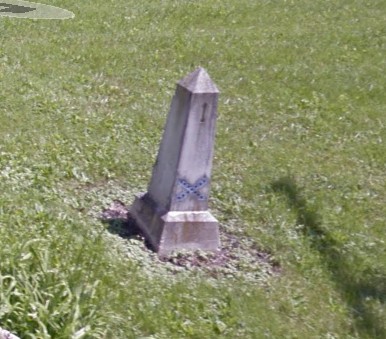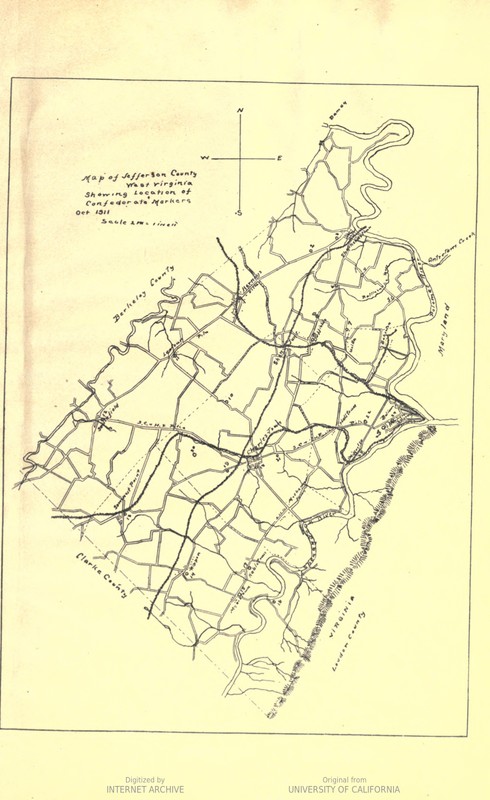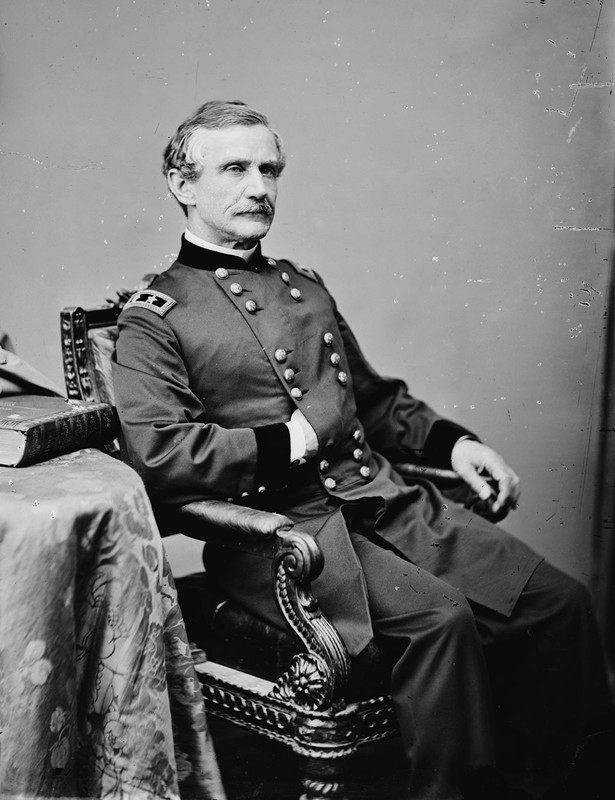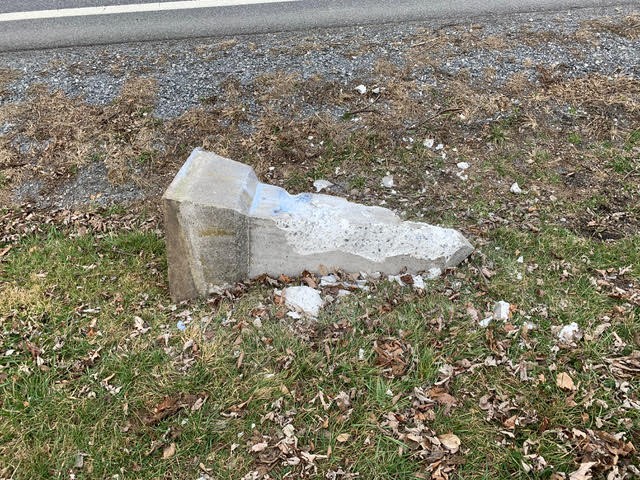UCV Civil War Military Operations Marker #1: Engagement at Kearnysville, October 16-17, 1862
Introduction
Text-to-speech Audio
Images
Marker #1

Map of obelisk locations

Union General Andrew A. Humphreys

Confederate General J. E. B. Stuart

Marker #1 was vandalized in February 2020 and removed by the Sons of Confederate Veterans.


Backstory and Context
Text-to-speech Audio
In the aftermath of the Battle of Antietam, the armies of McClellan and Lee spent a few weeks resting in camp. The Army of the Potomac (McClellan) remained on the battlefield near Sharpsburg, MD while Lee’s Army of Northern Virginia took up camp near Bunker Hill, VA (WV). In mid-October, McClellan moved his army towards Harpers Ferry with the object to retake the town from the Confederate forces there. To screen the movements of the main Union army, forces under Brigadier General Andrew A. Humphreys and Brigadier General Winfield S. Hancock crossed the Potomac River and advanced towards Kearneysville and Harpers Ferry/Charles Town respectively.
Brigadier General Humphreys crossed the Potomac at Butler’s Ford near Shepherdstown on October 16th with 6,000 infantry of the Fifth Corps, 500 cavalry, and 6 pieces of artillery. A few miles past Shepherdstown Humphreys’ forces met resistance from Confederate forces under Major General J.E.B. Stuart. Stuart’s men had been destroying part of the Baltimore & Ohio Railroad at Thompson’s Stephenson’s Station about six miles from Smithfield (now Middleway). In the late evening of the 16th there was an engagement between these two forces and after about 15 minutes of fighting the Confederate force retreated. The following morning, October 17, Humphreys continued his march towards Leetown and met more resistance just outside of Kearneysville. After a small engagement near Kearneysville, the Federal troops started to retreat back towards Shepherdstown and their camp at Sharpsburg. According to Confederate accounts, the Confederate resistance forced the Union troops to fall back and retreat across the Potomac to safety. According to Humphreys’ report of October 19, 1862 he received directions that the objective of their offensive was complete and both his force and that under Hancock would withdraw simultaneously. In the evening of October 17 Humphreys’ forces recrossed the Potomac towards their original camp at Sharpsburg.
The other force of this action, that under Brigadier General Hancock, also crossed the Potomac on October 16th. Hancock’s brigade, plus 1,500 additional infantry, 4 regiments of cavalry, and 4 artillery guns crossed near Harpers Ferry and headed towards Charles Town. The Union force advanced so quickly, they were able to break through the Confederate pickets between North Mountain and the Shenandoah River. During the advance, Hancock’s force met resistance from Confederate pickets at Halltown but pushed them back to about 1 mile outside Charles Town. The Confederates—infantry under Lieutenant John W. Carter and guns of R. P. Chew’s battery and the Richmond Howitzers—put up resistance on high ground outside Charles Town. Hancock’s Union troops were able push the Confederate troops back into Charles Town and ultimately forced them to evacuate the city. Union forces remained in Charles Town overnight and then returned to Harpers Ferry on October 17.
After this action of October 16-17, 1862, McClellan’s army retook Harpers Ferry and engaged in expeditions against Confederate forces and guerillas before the Army of the Potomac moved back into eastern Virginia before the Battle of Fredericksburg.
About the Monument:
This series of monuments and accompanying tour pamphlet were part of an initiative from the Jefferson County Camp, United Confederate Veterans to commemorate the 50th anniversary of the Civil War. In 1910 Col. R. Preston Chew and the Jefferson County UCV raised the funds to place 25 concrete obelisks in Jefferson County to mark locations of engagement or other significant events. The following year the Camp published a pamphlet to accompany the obelisks and give more information about each location. This was Military Operations in Jefferson County, Virginia (Now West Virginia), 1861-1865 published in 1911. The pamphlet has been reprinted several times by the Henry Kyd Douglas Camp, No. 199 of the Sons of Confederate Veterans. Because the monuments and accompanying pamphlet were done by Confederate veterans it is likely that the locations and descriptions are biased towards or favor the Confederate view and experience of the war.
Original text from the 1911 pamphlet:
"Markers One, Six, and Eight
Kearneysville, Uvilla, Crossing of Uvilla and Charles Town Roads
On the Sixteenth of October, 1862, Brigadier General Humphreys crossed the Potomac at Butler’s Ford, with Six Thousand Infantry, Five Hundred Cavalry, and Six pieces of artillery, and advanced on the roads leading to Kearneysville. Another force, commanded by Brigadier General W. S. Hancock, with his own brigade, fifteen hundred from other brigades, four regiments of cavalry, and four pieces of artillery, advanced from Harpers Ferry at the same time, in the direction of Charles Town. We had, at the time, a line of pickets extending from the North Mountain to the Shenandoah River. The advance was so sudden that it cut off some of the pickets.
Company D, of the Twelfth Virginia Cavalry, was picketing from Engle’s Hill to the Shepherdstown road. The reserve was near where Marker No. 8 stands, at the intersection of the Uvilla and Charles Town roads. A sharp encounter took places between the Federal advance and company D, a little south of this point in Rocky Lane. Captain Knott was wounded in the shoulder. Many of the company were from this section, and knew every road. They easily made their way through the enemy’s lines and joined the Regiment. Thus they played even; for about a month previous, our line of pickets were being advanced, and company D struck their pickets at Duffields, and chased them back on their company reserve at Marker 8. They held their own until the company had closed up, when a charge was made and they were driven to Lucas’ woods, where a regiment was stationed. They all decamped and crossed the Potomac.
Humphrey’s advance guard went as far as Smithfield, and his main body a little south of Kearneysville. The Confederates had been destroying the railroad in this section, and some of General Winder’s Infantry was near. They, with Fitz Lee and Hampton’s Brigades of Cavalry, commanded by General Stuart, attacked late in the evening of the Sixteenth of October, (Marker No. 1), and, after some severe fighting, drove him from his position. They were steadily driven back on the Seventeenth, but made a determined stand two miles south of Shepherdstown, on the Shepherdstown and Duffields road at what is called the Forks. A brigade of regulars, commanded by Major Lovell, U.S.A. occupied this part of the field, and the importance of holding it was apparent. Back of him was the Trough road which led to the ford on the Potomac and also the road leading to Shepherdstown. If the position were carried his retreat was endangered. Trees were felled across the road to impede the artillery and cavalry, but Winder’s infantry forced them back slowly, and the whole force crossed into Maryland.
The losses on both sides were considerable. No estimate of the losses could be found. Our badly wounded were taken to the Uvilla churches and neighboring farm houses, and cared for. Many wounded had been left at these churches after the battle of Sharpsburg, and those unable to get away were paroled by the Federals. At this point is planted Marker No. 6."
Cite This Entry
Historic Landmarks Commission, Jefferson County and Kathleen Thompson. "UCV Civil War Military Operations Marker #1: Engagement at Kearnysville, October 16-17, 1862." Clio: Your Guide to History. February 19, 2021. Accessed March 22, 2025. https://theclio.com/tour/1805/1
Sources
Bushong, Millard Kessler. A History of Jefferson County, West Virginia. Charles Town, WV: Jefferson Publishing Company, 1941.
Engle, Stephen Douglas. Thunder in the Hills: Military Operations in Jefferson County, West Virginia, During the American Civil War. Charleston, WV: Mountain State Press, 1989.
Military Operations in Jefferson County Virginia (and West Va.) 1861-1865. Published by Authority of Jefferson County Camp U.C.V. Farmers Advocate Print, 1911. Accessed January 20, 2021. https://babel.hathitrust.org/cgi/pt?id=uc2.ark:/13960/t4vh5gp6c&view=1up&seq=5.
Report of October 19, 1862 by A. A. Humphreys. Official Records of the War of the Rebellion Series 1, Vol. 19, pt. 2, pp. 85-88. “Timeline of West Virginia: Civil War and Statehood: October 16-17, 1862.” Child of the Rebellion: An Archives and History Sesquicentennial Project. West Virginia Department of Arts, Culture and History. Accessed January 20, 2021. http://www.wvculture.org/history/sesquicentennial/18621017.html.
Google Maps. Accessed January 20, 2021.
Military Operations in Jefferson County Virginia (and West Va.) 1861-1865. Published by Authority of Jefferson County Camp U.C.V. Farmers Advocate Print, 1911. Accessed January 20, 2021. https://babel.hathitrust.org/cgi/pt?id=uc2.ark:/13960/t4vh5gp6c&view=1up&seq=5.
"Andrew A. Humphreys." Wikipedia. Accessed January 20, 2021. https://en.wikipedia.org/wiki/Andrew_A._Humphreys.
"J. E. B. Stuart." Wikipedia. Accessed January 20, 2021. https://en.wikipedia.org/wiki/J._E._B._Stuart.
Photo provided by Martin Burke, February 18, 2021.

